
Water pools behind the Iron Gate Dam on the Klamath River.
Sage Van Wing / OPB
Like many places in the arid West, water is the lifeblood of the Klamath Basin. And it is in short supply. Although many in the community have been working together for years to try to come to an agreement about how to share limited water resources equitably, the unprecedented drought this year has native tribes, irrigators, fishermen and wildlife managers all asking an existential question: If we can’t go on like this, what is a viable path forward?
Recently, OPB’s Think Out Loud team traveled to the Klamath Basin to talk to a number of people whose lives and livelihoods and cultures are all connected to the water.
So many of these conversations revolved around something that dates back to the beginning of the 20th century. That’s when the federal government’s Bureau of Reclamation put in a series of dams, dikes and canals that dried up lakes to create farmland and then they diverted water to irrigate crops. They called it the Klamath Project.
The Klamath Tribes councilman
Clayton Dumont is a member of the tribal council for the Klamath Tribes. We met up with him along the Williamson River, which feeds into Klamath Lake. The lake is the home to two species of sucker fish that are deeply tied to the tribe’s history and culture. They are also at risk of going extinct.
Dumont: Our legends tell us that our creator Gmok’am’c told us that if the sucker fish die, we die. A lot of folks think of that as a literal correlation, but of course we think about it as those fish being a kind of indicator species. ... If they can’t make it, then all the other species are suffering too, and we know that that’s the case. Most of our first foods, our traditional foods are on the brink.
Dumont says the Klamath Tribes are working on their own land, and with local ranchers on stream restoration and farming practices, to improve the water quality in the lake.
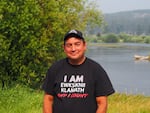
Clayton Dumont is a tribal councilman for the Klamath Tribes.
Dave Miller / OPB
Dumont: The agricultural footprint has to be much smaller. It has to be much smarter. You can still drive around out here and see flood irrigating, where folks are simply tapping into springs that used to feed cold clean rivers and irrigating their fields, so the cattle are out there ankle deep. I have a neighbor where there’s water running down the sides of the road. It’s obscene. We have to get a lot smarter about it, and it has to be smaller.
Related: Audio: OPB talks with Clayton Dumont
The rancher
Becky Hyde is what’s called an off-Project rancher. That means the water she relies on comes from the streams and tributaries that flow into the lake, rather than the lake itself. Her family ranches in various parts of the upper Klamath Basin and she is on the Oregon Fish and Wildlife Commission.
Hyde: The water on that ranch was called before the irrigation season even started this year because of the drought. It was appropriate because there is no water. All you have to do is look at a hydrograph of the upper basin to understand what a tight situation we’re in with this extreme drought. On that ranch we currently only have a third of the number of animals we normally would have. Of the third left, we probably have two and half weeks of grass left.
Hyde says that the drought this year has hurt everyone equally. And in order to create an ecosystem that has more water to go around — and is more resilient — people are going to have to work together.
Hyde: The first thing I see, in terms of resiliency for this region, is that everybody needs to get to the table and wake up. In the past we had models in this basin where agriculture, both above Klamath Lake and the tributaries and the farming community, all of the tribes in this basin sat down together and talked about the serious situation we have around water. And that should be the priority of everyone in this basin and all the time from now on. Because for the last five years we have had little squabbles with one another, we are seeing the result of that today. … This isn’t a farmer versus fish problem. This is a problem of communities coming together, really waking up, working on resiliency, working on healing this ecosystem together and then sending a strong message to state and federal partners to begin addressing the weak links here so that we don’t go year after year after year with some sort of drought emergency aid. We need systemic change here now. We’ve needed it for 20 years.
Related: Audio: OPB talks with rancher Becky Hyde about the drought and wildfires
The farmer
Ben DuVal is an Alfalfa farmer and president of the Klamath Water Users Association. He ranches on land that used to be underneath the lake before the reclamation project was built. He says this rich farmland is some of the most productive and efficient irrigated land in the country. Or it would be, if it got more of the water that is being stored in Upper Klamath Lake, or being sent down the river to make better habitat for salmon.
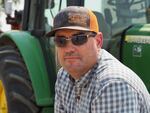
Ben DuVal is a farmer and president of the Klamath Water Users Association
Dave Miller / OPB
DuVal: This area should not be known for its water problems. ...There’s not too many demands on the water. There’s too many competing demands on the water because everybody wants more. I think we need to go back to a balanced approach. You know, I don’t think that in a year like this, the river shouldn’t be running bank full and I don’t think that my farm should be getting zero irrigation water. I think that we need some balance there, and we need to look at all the benefits that irrigated ag in this area provides to the communities, to the wildlife refuges, to the amount of private habitat that we ordinarily provide on our private lands. ... I don’t feel that any party in this should win. Like this year the river is winning, the entire project is not diverting any water this year, the river is taking it all and that’s not right. So what I envision is just some balance to it. There is a way to have sustainable farms here on the Klamath Project, and there’s ways to have a sustainable, healthy fishery on the river.
Related: Audio: OPB's Dave Miller visits with farmer Ben DuVal
The water advocate
The Klamath Basin is also home to six national wildlife refuges which support a diverse population of resident and migratory wildlife, including over three quarters of the Pacific Flyway waterfowl. Jim McCarthy, Southern Oregon program director for WaterWatch of Oregon, says the water in the Refuge wetlands used to be an important part of the resiliency of the region.
McCarthy: The U.S. Geological Survey has done a lot of work on this basin and they have written a report which the Bureau of Reclamation has ignored. The USGS has shown that the surface water and groundwater are connected. So when you draw more groundwater during droughts like everyone does, there’s a limit that’s sustainable. If you take more than what is sustainable, the groundwater is not going to be there or it’s gonna cost you double or you’re gonna have to drill down deeper. … Our political leaders have seized on digging deeper as their salvation in this problem. They don’t want to do the hard work of passing “surface water demand reduction” packages that are unpopular with one interest group in this basin, the Klamath Project irrigators, who want to maintain an absolute 330,000 acre-feet minimum into the Project, meaning the Project doesn’t shrink. Everybody else can shrink, the fishery can shrink, the refuges can disappear. The upper basin irrigators can dry up and blow away. But the Klamath Project is gonna stay at 330,000 acre feet minimum during a drought.
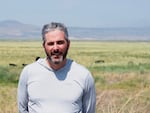
Jim McCarthy is the Southern Oregon program director for WaterWatch of Oregon.
Dave Miller / OPB
McCarthy says he would like to see federal buyouts of willing sellers in the agricultural community to reduce overall demand throughout the basin.
McCarthy: You can have an agricultural sector that is smaller but does not lurch from one federal disaster package to another, but instead exists in a steady state that is sustainable. Same thing with the fishery and the national wildlife refuges. This is literally the Everglades of the West, an unparalleled wetland complex. It is also one of the places where you have mass die-offs of waterfowl due to lack of water on a scale you don’t really see in other places.
Related: OPB talks with RiverWatch's Jim McCarthy
‘The Coalition’
Water users throughout the Klamath Basin actually came together and sent a compromise called the Klamath Basin Restoration Agreement to Congress five years ago. It was a huge effort, which took over 10 years to plan, and was aimed at codifying water rights in the basin. But Congress failed to pass the legislation that would have implemented it.
Now, a new group of people are working together to try to find common ground on water issues in the basin. They call themselves “The Coalition.”
Chrysten Lambert is the Oregon Director of Trout Unlimited, and a member of the Coalition as a private citizen. She says this group’s work is very much trying to rebuild after the failure of the KBRA negotiations.
Lambert: When that fell apart, things really fractured across the basin and communities and people kind of went into their individual bunkers and weren’t in good dialogue with each other. And so it was really an opportunity for people to come back, reconnect, understand each other as individuals and their needs and try to have conversations that are outside of the court system.
Dan Keppen is the Executive Director of the Family Farm Alliance and is a member of the Coalition as a private citizen. He says that the drought this year might offer an opportunity to bring people together.
Keppen: The only silver lining that comes out of this drought is it shows what we could have had, had the agreement been in place. … The whole idea of the KBRA was looking at sort of a watershed-wide approach to all the stressors that are affecting the fish. So, roughly in a year like this, the water would have been split a third, a third, a third for water behind the lake, the suckers, water downstream for coho salmon, a third of the water basically going to the Irrigation Project, but lots of other dollars are going to be put out there to do other things that would help the fish restoration projects, things up in Upper Klamath Lake that would also affect the fish in ways that don’t necessarily tie to the flows.
Related: Audio: OPB talks with Chrysten Lambert and Dan Keppen of "The Coalition"
The downstream interests
The water that eventually makes it out of the Upper Lake, the Klamath Project lands and the refuges flows down into Klamath River. The river provides habitat for multiple runs of endangered salmon that are important to several tribes whose homelands border the river as it makes its way through Northern California to the Pacific Ocean. The flow of the river is impeded by four dams built over 100 years ago and currently run by Pacificorp. But those dams are slated to be removed in just a few years. If it comes to pass, it will be the largest dam removal project in the country’s history.
Earlier this year, federal regulators approved the transfer of the hydroelectric license from PacificCorp to a nonprofit called the Klamath River Renewal Corporation, plus the states of Oregon and California.
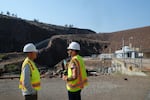
The Iron Gate Dam is the lowest of four dams on the Klamath River that are set to come down in a few years. Mark Bransom, left, speaks with OPB's Dave Miller.
Sage Van Wing / OPB
We spoke to Mark Bransom, the CEO of the Klamath River Renewal Corporation, at the bottom of the Iron Gate Dam. He says the removal project is not just about improving habitat for salmon, but also about adding resiliency into the ecosystem of the entire basin.
Bransom: We’ve always maintained that the return of the fish is good for agriculture, as well as for the tribes and other communities that are interested in seeing a return of these fish runs. The agricultural communities are under tremendous regulatory pressure. They see a lot of water come down the river to offset some of the water quality impacts that result from the presence of the dam. And I’m fully convinced that once the dams are gone and the fish return, some of those regulatory pressures are going to be relieved. The agricultural community is going to benefit by being able to hold on to additional water that can be used for agricultural or other purposes, that today needs to be released down river to address the fish diseases and other water quality conditions that we have today, that we assume will be alleviated by removal of the dams.
Troy Hockaday saw the effects of those fish diseases first hand. He’s a traditional dip net fisherman and a member of the Karuk Tribal Council. Last spring low water flows and high temperatures in the river led to the die off of up to 97% of the young salmon making their way upstream.
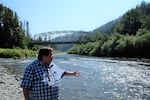
Karuk Tribal Council member Troy Hockaday stands at the junction of Indian Creek and the Klamath River in 2021.
Sage Van Wing / OPB
Hockaday: Living here and growing up here all my life, this is the one of the worst I’ve ever seen it. ... When they put the dams in, back in the ’60s, it was a good idea. But now the effects of having those dams in are showing up. It’s showing up big and fast. They didn’t look at the long-term effects and what would happen to the river where they put them in. … So now, as us, growing up here, our lives, now that we’ve got to learn how to react and change it back to where it used to be, or some way we can get back to normal. … I mean right now it’s bad because it’s a big bad drought for the last two years. But we’ve all got to make compromises. We can’t sit there and let the government tell us what to do if they don’t live here. We live here. The farmers live here. The Native Americans live here. The communities of Happy Camp, Orleans, and Weitchpec, we all live here. We are here every day. We know what’s right for this river. We’ve been here for generations, thousands of years.
Related: Audio: OPB speaks with Mark Bransom and Troy Hockaday
Barry McCovey, Fisheries Department director for the Yurok Tribe, currently runs massive river restoration efforts along the Klamath and many of its tributaries. If the dams do come down, he projects restoration efforts will take at least 10 years, if not longer.

Barry McCovey, Fisheries Department director for the Yurok Tribe, stands on the tribe's fishing dock where the Klamath River meets the Pacific Ocean.
Sage Van Wing / OPB
McCovey: We’ve already started the initial stages of this project. That’s collecting seeds and propagating plants that will be planted in the footprint of the reservoirs that will be drained. Those plantings will help to stabilize the banks. ... And then there’s gonna be a lot of mechanical restoration on the tributaries that enter the Klamath River in the reservoir reach. We’re really excited and we really are looking forward to that opportunity to be able to work on restoring that section of river because it’s been lost for so long. … I’m optimistic that the resiliency of these fish will bring them through, if we can keep them on life support and get through this tough time. And if we can build in some resiliency in the habitat and in the basin, the fish will respond. They’ve always been there for us and I don’t see that changing. We just have to be there for them.
Amy Bowers Cordalis is an attorney for the Yurok Tribe and a principal at the Ridges to Riffles Conservation Fund, a nonprofit that works on Native American cultural and natural resource issues. She says people up and down the basin need to start thinking about sustainability, because the status quo isn’t working for anybody.
Bowers Cordalis: We always ask ourselves first, ‘What do the fish need? What does the river need?’ So we always start with that, in terms of any advocacy strategy. I think, where there can be compromise is that, right now, the river is super unhealthy: because of the dams, because of all the runoff from the project, the agricultural runoff, because of bad habitat throughout the whole basin. There are all kinds of things that are making the river sick. We’ve used the land from here all the way to the very, very headwaters as sort of an industrial machine and we haven’t taken care of any of the ecosystem. ... When we start taking care of the river, and I mean the tributaries, above upper Klamath Lake, the river starts getting more healthy and then we can have some flexibility about management.
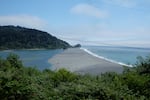
The Klamath River meets the Pacific Ocean in Klamath, Calif. Here, the mouth of the river is viewed from the village of Requa and the ancestral home of Amy Bowers Cordalis.
Sage Van Wing / OPB
Related: Audio: OPB talks with Barry McCovey and Amy Bowers Cordalis
To listen to all of the interviews, visit Think Out Loud.